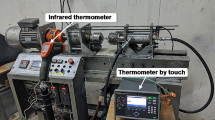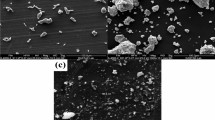Abstract
The objective of this study aimed to investigate the effect of plastic deformation rate and heat treatment routes on the wear performance of surfaced coatings obtained using submerged arc welding (SAW) and flux supplemented by additions of alloying powder. Powder of cemented tungsten carbide and high-speed tool steel has been selected as additives to the composition of shielding flux AMS1. Graphite powder was used as addition in two test batches in order to compensate carbon content, which burns out during welding. Results of spectrum analysis have revealed high concentration of alloying elements (Co 0.91–1.573%, W 2.5–9.5%, Mn 1.67–2.39%), which ensured low wear of tested coatings. Tempering at different temperatures showed formation of retained austenite; this fact was confirmed after X-ray diffraction analysis. Different extent of plastic deformation was accomplished to all test batches on the purpose of evaluation of influence on the wear performance of coatings. Wear results showed proportional dependence of rate of deformation and weight loss values. Addition of graphite helped to reach the lowest wear of coatings obtained using the flux alloyed with cemented tungsten carbide and high-speed tool steel (weight loss 0.12 and 0.148 g, respectively).



Similar content being viewed by others
References
Lu K, Lu J (1999) Surface nanocrystallization (SNC) of metallic materials-presentation of the concept. J Mater Sci Technol 15(3):193–197
Valiev RZ, Langdon TG (2006) Principles of equal-channel angular pressing as a processing tool for grain refinement. Prog Mater Sci 51(7):881–981
Levin ZS, Hartwig KT (2015) Hardness and microstructure of tungsten heavy alloy subjected to severe plastic deformation and post-processing heat treatment. Mater Sci Eng A 635:94–101
Kocich R, Kunčicka L, Dohnalik D, Machačkova A, Šofer M (2016) Cold rotary swaging of a tungsten heavy alloy: numerical and experimental investigations. Int J Refract Met Hard Mater. doi:10.1016/j.ijrmhm.2016.10.005
Yamanaka K, Mori M, Yoshiba K, Kuramoto K, Chiba A (2016) Manufacturing of high-strength Ni free Co-Cr-Mo alloy rods via cold swaging. J Mech Behav Biomed Mater 60:38–47
Bian H, Li Y, Wei D, Cui Y, Wang F, Sun S, Yamanaka K, Koizumi Y, Chiba A (2016) Precipitation hehavior of a novel cobalt-based superalloy subjected to prior plastic deformations. Mater Design 112:1–10
Arabi-Jeshvaghani R, Harati E, Shamanian M (2011) Effects of surface alloying on microstructure and wear behaviour of ductile iron surface-modified with a nickel-based alloy using shielded metal arc welding. Mater Des 32:1531–1536
Tušek J, Suban M (2003) High-productivity multiple-wire submerged-arc welding and cladding with metal-powder addition. J Mater Process Technol 133:207–213
Soy U (2011) Comparison of steels via SMAW and MIG welding methods under industrial loads. Steel Compos Struct 11(3):225–232
Mendez PF, Barnes N, Bell K, Borle SD, Gajapathi SS, Guest SD, Izadi H, Gol AK, Wood G (2014) Welding processes for wear resistant overlays. J Manuf Process 16:4–25
Ambroza PA, Kavaliauskiene L, Pupelis E (2010) Automatic arc welding and overlaying welding of steel using waste materials powder. Mechanics 2(82):75–79
Beševic M (2012) Experimental investigation of residual stresses in cold formed steel sections. Steel Compos Struct 12(6):465–489
Bendikiene R, Pupelis E, Kavaliauskiene L (2016) Effects of surface alloying and laser beam treatment on the microstructure and wear behaviour of surfaces modified using submerged metal arc welding. Materials science-Medžiagotyra 22(1):44–48
Pupelis E (2013) Strengthening of steel product surface by overlay welding and laser beam treatment, Ph.D. Dissertation. Kaunas University of Technology, Kaunas
Bradley MSA, Bingley MS, Pittman AM (2000) Abrasive wear of steels in handling of bulk particulates: an appraisal of wall friction measurement as an indicator of wear rate. Wear 243(1–2):25–30
Song C, Yu H, Li L, Shou T, Lu J, Liu.X. (2016) The stability of retained austenite at different locations during straining of I&Q&P steel. Mater Sci Eng A 670:326–334
Bendikiene R, Pupelis E (2016) Application of surfaced cutters for machining of wood-based materials. Wood Research 61(1):155–162
Hui W, Zhang Y, Zhao X, Shao C, Wang K (2016) Influence of cold deformation and annealing on hydrogen embrittlement of cold hardening bainitic steel for high strength bolts. Mater Sci Eng A 662:528–536
Talha M, Behera CK, Sinha OP (2015) Effect of nitrogen and cold working on structural and mechanical behavior of Ni-free nitrogen containing austenitic stainless steels for biomedical applications. Mater Sci Eng, C 47:196–203
Speer J, Matlock DK, De Cooman BC, Schroth JG (2003) Carbon partitioning into austenite after martensite transformation. Acta Mater 51:2611–2622
Clarke AJ, Speer JG, Miller MK, Hackenberg RE, Edmonds DV, Matlock DK, Rizzo FC, Clarke KD, De Moor E (2008) Carbon partitioning to austenite from martensite of bainite during the quench and partition (Q&P) process: a critical assessment. Acta Mater 56:16–22
Roy S, Sundararajan S (2016) The effect of heat treatment route on the retained austenite and tribomechanical properties of carbiruzed AISI 8620 steel. Surf Coat Technol. doi:10.1016/j.surfcoat.2016.06.095
Yaso M, Hayashi S, Morito S, Ohba T, Kubota K, Murakami K (2009) Characteristics of retained austenite in quenched high C-high Cr alloy steels. Mater Trans JIM 50(2):275–279
Zhao L, van Dijk NH, Brück E, Sietsma J, van der Zwaag S (2001) Magnetic and X-ray diffraction measurements for the determination of retained austenite in TRIP steels. Mater Sci Eng A 313(1–2):145–152
Li ZC, Ding H, Misra RDK, Cai ZH (2017) Deformation behavior in cold-rolled medium-manganese TRIP steel and effect of pre-strain on the Lüders bands. Mater Sci Eng A 679:230–239
Author information
Authors and Affiliations
Corresponding author
Additional information
Recommended for publication by Commission II - Arc Welding and Filler Metals
Rights and permissions
About this article
Cite this article
Bendikiene, R., Kavaliauskiene, L. The effect of plastic deformation rate on the wear performance of hardfaced coatings. Weld World 61, 893–900 (2017). https://doi.org/10.1007/s40194-017-0476-3
Received:
Accepted:
Published:
Issue Date:
DOI: https://doi.org/10.1007/s40194-017-0476-3




